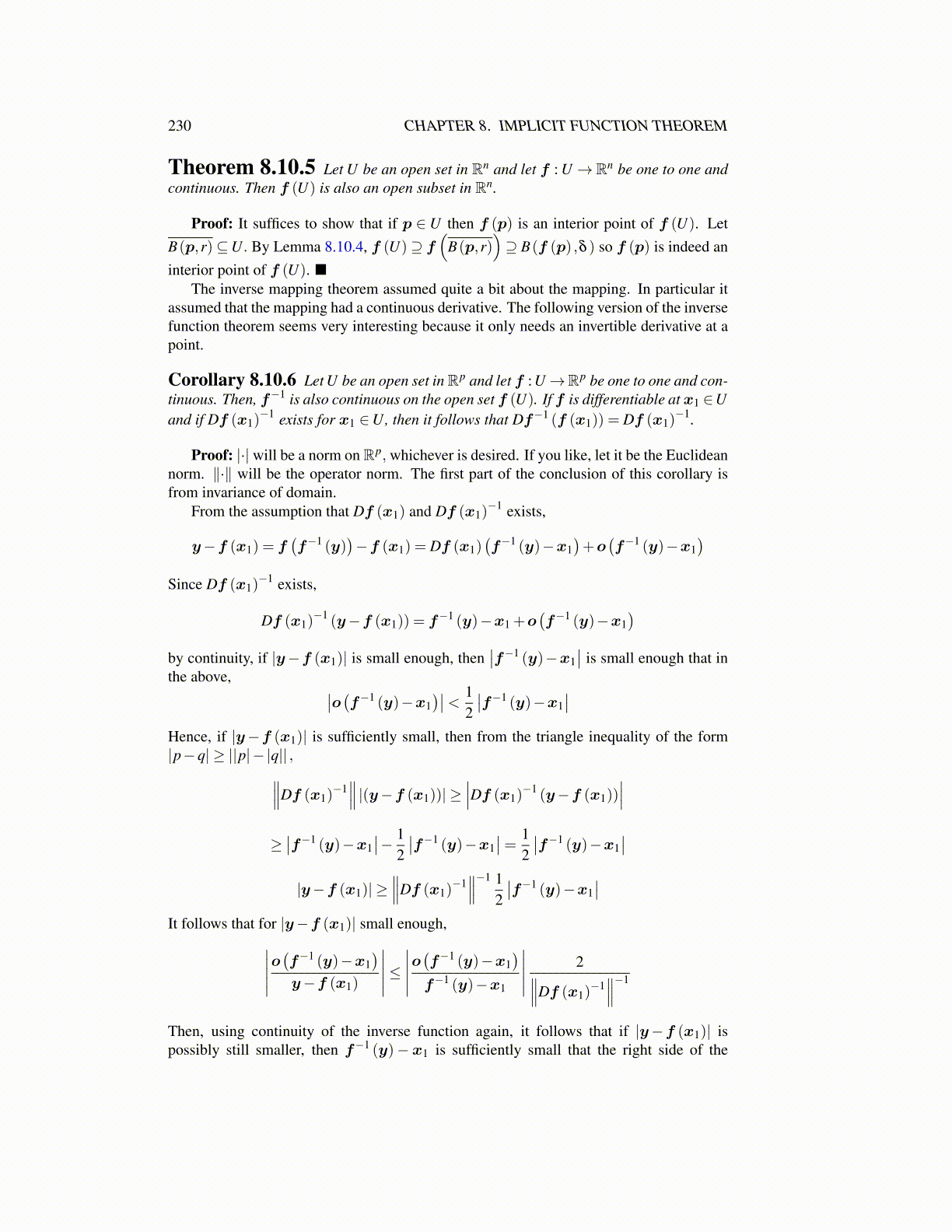
230 CHAPTER 8. IMPLICIT FUNCTION THEOREM
Theorem 8.10.5 Let U be an open set in Rn and let f : U → Rn be one to one andcontinuous. Then f (U) is also an open subset in Rn.
Proof: It suffices to show that if p ∈U then f (p) is an interior point of f (U). LetB(p,r)⊆U. By Lemma 8.10.4, f (U)⊇ f
(B(p,r)
)⊇ B(f (p) ,δ ) so f (p) is indeed an
interior point of f (U). ■The inverse mapping theorem assumed quite a bit about the mapping. In particular it
assumed that the mapping had a continuous derivative. The following version of the inversefunction theorem seems very interesting because it only needs an invertible derivative at apoint.
Corollary 8.10.6 Let U be an open set inRp and let f : U→Rp be one to one and con-tinuous. Then, f−1 is also continuous on the open set f (U). If f is differentiable at x1 ∈Uand if Df (x1)
−1 exists for x1 ∈U, then it follows that Df−1 (f (x1)) = Df (x1)−1.
Proof: |·| will be a norm on Rp, whichever is desired. If you like, let it be the Euclideannorm. ∥·∥ will be the operator norm. The first part of the conclusion of this corollary isfrom invariance of domain.
From the assumption that Df (x1) and Df (x1)−1 exists,
y−f (x1) = f(f−1 (y)
)−f (x1) = Df (x1)
(f−1 (y)−x1
)+o
(f−1 (y)−x1
)Since Df (x1)
−1 exists,
Df (x1)−1 (y−f (x1)) = f
−1 (y)−x1 +o(f−1 (y)−x1
)by continuity, if |y−f (x1)| is small enough, then
∣∣f−1 (y)−x1∣∣ is small enough that in
the above, ∣∣o(f−1 (y)−x1)∣∣< 1
2
∣∣f−1 (y)−x1∣∣
Hence, if |y−f (x1)| is sufficiently small, then from the triangle inequality of the form|p−q| ≥ ||p|− |q|| ,∥∥∥Df (x1)
−1∥∥∥ |(y−f (x1))| ≥
∣∣∣Df (x1)−1 (y−f (x1))
∣∣∣≥∣∣f−1 (y)−x1
∣∣− 12
∣∣f−1 (y)−x1∣∣= 1
2
∣∣f−1 (y)−x1∣∣
|y−f (x1)| ≥∥∥∥Df (x1)
−1∥∥∥−1 1
2
∣∣f−1 (y)−x1∣∣
It follows that for |y−f (x1)| small enough,∣∣∣∣∣o(f−1 (y)−x1
)y−f (x1)
∣∣∣∣∣≤∣∣∣∣∣o(f−1 (y)−x1
)f−1 (y)−x1
∣∣∣∣∣ 2∥∥∥Df (x1)−1∥∥∥−1
Then, using continuity of the inverse function again, it follows that if |y−f (x1)| ispossibly still smaller, then f−1 (y)− x1 is sufficiently small that the right side of the